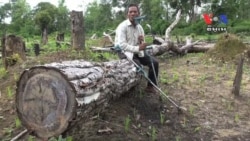Indigenous communities in Ratanakkiri province say the government’s economic land concession policy is taking away their land and traditional way of life. Increasingly, people here fear that the spread of private plantations, which cut down forests and push people from their traditional lands on land leased from the government, are a threat to their identity.
Seoung Sarat, a member of the Tompuon tribe and father of five children, survived several regimes and civil wars in Cambodia. He came out mostly unscathed. But in 2009, when his country was at peace, he was shot in the leg during a land conflict with a private company. He lost his right leg as a result.
“The local authorities had collected our family record books and other identity documents and told the company that the villagers had already agreed to sell their land, but in fact I did not know,” he said in a recent interview. “I didn’t know the land on which I had been living had been sold. I didn’t know at all.”
He blames his misfortune on poor governance.
“I thought we the people lived under the government’s leadership, but in contrast the government is not honest with the people,” he said. “They took our names and sold our land and then took the money. Some have bought cars and other things, while the people have nothing and are miserable. When I stood up to protest, they said they had already given the land to the company, so the company ordered their soldiers to shoot me.”
Seoung Sarat was among other indigenous people who had been resisting forced evictions from their land, where they say they have been living and planting cashews for years before the company came in. He has been reduced to begging.
“There is nothing I can do but die, not from disease but from hunger,” he said. “As a handicapped man like me, even if I beg, no one will offer me any money. They often said I was rebellious and against the powerful, against the government, but I was against no one. I was just asking that the government not do the same as the three-year Pol Pol regime.”
Seoung Sarat has been seeking help from non-governmental organizations and filing complaints to the provincial court, but he said his case has not been processed. Without land or a house of his own, Seoung Sarat and his family decided to ask another indigenous community for a temporary stay. Pnheunh Therm, his wife, said they have been reduced to poverty, living in a small wooden house with no means of income. “They stole the land and shot the owner too. The owners were already poor, and now they made us poorer. I wonder, why have they done this?”
Nationwide, the concessions amount to a lot of land. By 2013, about 2.5 million hectares, about 70 percent of the country’s arable land, was leased to more than 270 companies. That has disproportionately affected the indigenous groups, the environmental watchdog Global Witness says.
In Ratanakkiri, at least seven different minority groups still maintain their way of life: the Tompuon, Kreung, Charay, Kachak, Lon, Kaveth and Prov. These communities depend mainly on land and forest goods. Many of them are facing the loss of their land and traditional way of life to economic land concessions granted to private companies for agro-businesses.
“In the future, they will be all gone,” said Nhan Nea, program officer for Higherlanders Association. “This is based on what we have seen, because now the loss is at the current level, so what about in the future?”
Local rights groups say the government’s land concession policy has not improved life in the indigenous communities; instead, it has made it worse.
Chhay Thy, the local coordinator for rights group Adhoc, has been monitoring land concessions. The companies, not the people, gain the benefits of concessions, he said.
“With regard to the indigenous people here, they lack knowledge and are not accustomed to working for companies,” he said. “Based on their tradition and culture, they won’t turn themselves into those companies’ laborers. Also, we see that those investment companies often have conflicts with the people, so the people have already lost trust in them and are not happy at all with the company’s development.”
Le Then Lam, a branch manager for Hoang Anh Gia Lai, which has received tens of thousands of hectares of economic land concessions from the Cambodian government, said his company has never encroached on indigenous community land.
“Some farmlands of villagers did not appear on our map, but when we came physically, we saw some existing farmland,” he said through a translator. “However, we inform the local authorities about this, and if the land belongs to the villagers, we keep it for them.”
Ratanakkiri provincial head of the Environment Department, Chou Sopheak, said the land concessions have not caused a loss of land for indigenous people.
“In general, by government policy, I can say that it cannot lead to the fact that our people will have no land; it’s impossible,” he said. “But if they sell their land by themselves, no matter how much land they have, it won’t be sufficient for them. Anyway, according to the current government policy, if the land belongs to you, we’ll give it back to you.”
Recently the government has cancelled and taken back some concessions from companies and announced it would continue to do so. Seoung Sarat, however, said he does not expect to get back his farmland back. “If the government really wants to reform their policy so that the people will not suffer from hunger or lose their indigenous culture, they need to distribute the land to both the company and the people,” he said. “But if they don’t want to give it to the people, then the people will just have nothing, forever.”








